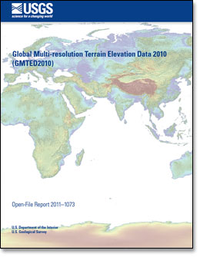In 1996, the U.S. Geological Survey (USGS) developed a global topographic elevation model designated as GTOPO30 at a horizontal resolution of 30 arc-seconds for the entire Earth. Because no single source of topographic information covered the entire land surface, GTOPO30 was derived from eight raster and vector sources that included a substantial amount of U.S. Defense Mapping Agency data. The quality of the elevation data in GTOPO30 varies widely; there are no spatially-referenced metadata, and the major topographic features such as ridgelines and valleys are not well represented. Despite its coarse resolution and limited attributes, GTOPO30 has been widely used for a variety of hydrological, climatological, and geomorphological applications as well as military applications, where a regional, continental, or global scale topographic model is required. These applications have ranged from delineating drainage networks and watersheds to using digital elevation data for the extraction of topographic structure and three-dimensional (3D) visualization exercises (Jenson and Domingue, 1988; Verdin and Greenlee, 1996; Lehner and others, 2008). Many of the fundamental geophysical processes active at the Earth's surface are controlled or strongly influenced by topography, thus the critical need for high-quality terrain data (Gesch, 1994). U.S. Department of Defense requirements for mission planning, geographic registration of remotely sensed imagery, terrain visualization, and map production are similarly dependent on global topographic data.
Since the time GTOPO30 was completed, the availability of higher-quality elevation data over large geographic areas has improved markedly. New data sources include global Digital Terrain Elevation Data (DTEDRegistered) from the Shuttle Radar Topography Mission (SRTM), Canadian elevation data, and data from the Ice, Cloud, and land Elevation Satellite (ICESat). Given the widespread use of GTOPO30 and the equivalent 30-arc-second DTEDRegistered level 0, the USGS and the National Geospatial-Intelligence Agency (NGA) have collaborated to produce an enhanced replacement for GTOPO30, the Global Land One-km Base Elevation (GLOBE) model and other comparable 30-arc-second-resolution global models, using the best available data. The new model is called the Global Multi-resolution Terrain Elevation Data 2010, or GMTED2010 for short. This suite of products at three different resolutions (approximately 1,000, 500, and 250 meters) is designed to support many applications directly by providing users with generic products (for example, maximum, minimum, and median elevations) that have been derived directly from the raw input data that would not be available to the general user or would be very costly and time-consuming to produce for individual applications. The source of all the elevation data is captured in metadata for reference purposes. It is also hoped that as better data become available in the future, the GMTED2010 model will be updated.


